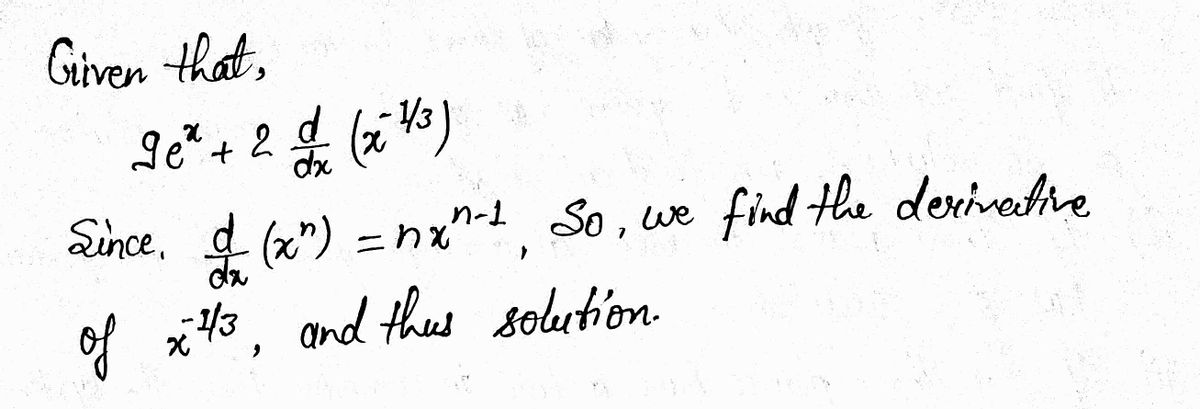Calculus: Early Transcendentals
8th Edition
ISBN:9781285741550
Author:James Stewart
Publisher:James Stewart
Chapter1: Functions And Models
Section: Chapter Questions
Problem 1RCC: (a) What is a function? What are its domain and range? (b) What is the graph of a function? (c) How...
Related questions
Question
![The image contains a mathematical expression related to differentiation rules, specifically the power rule for derivatives and its application.
1. **Power Rule for Derivatives**:
- The formula shown is: \( \frac{d}{dx}(x^n) = nx^{n-1} \)
- This rule states that the derivative of \( x^n \) with respect to \( x \) is \( n \) times \( x \) raised to the power of \( n-1 \).
2. **Application of the Power Rule**:
- The text mentions the application of the power rule to a specific function.
- The expression is:
\[
9e^x + 2 \frac{d}{dx}\left(x^{-1/3}\right) = 9e^x - \boxed{\phantom{}}\)
\]
- The derivative of \( x^{-1/3} \) needs to be calculated using the power rule, and the result will complete the equation within the box.
- In this context, \( x^{-1/3} \) is differentiated, and the result should replace the box to find the complete expression.
No graphs or diagrams are present in the image.](/v2/_next/image?url=https%3A%2F%2Fcontent.bartleby.com%2Fqna-images%2Fquestion%2F0fac6bec-f0b2-4056-963f-cf73547656d5%2Ff0254832-28e3-408b-9ece-a80d39705922%2Ft03hlis_processed.jpeg&w=3840&q=75)
Transcribed Image Text:The image contains a mathematical expression related to differentiation rules, specifically the power rule for derivatives and its application.
1. **Power Rule for Derivatives**:
- The formula shown is: \( \frac{d}{dx}(x^n) = nx^{n-1} \)
- This rule states that the derivative of \( x^n \) with respect to \( x \) is \( n \) times \( x \) raised to the power of \( n-1 \).
2. **Application of the Power Rule**:
- The text mentions the application of the power rule to a specific function.
- The expression is:
\[
9e^x + 2 \frac{d}{dx}\left(x^{-1/3}\right) = 9e^x - \boxed{\phantom{}}\)
\]
- The derivative of \( x^{-1/3} \) needs to be calculated using the power rule, and the result will complete the equation within the box.
- In this context, \( x^{-1/3} \) is differentiated, and the result should replace the box to find the complete expression.
No graphs or diagrams are present in the image.
Expert Solution
Step 1: Explanation

Step by step
Solved in 2 steps with 2 images

Recommended textbooks for you

Calculus: Early Transcendentals
Calculus
ISBN:
9781285741550
Author:
James Stewart
Publisher:
Cengage Learning

Thomas' Calculus (14th Edition)
Calculus
ISBN:
9780134438986
Author:
Joel R. Hass, Christopher E. Heil, Maurice D. Weir
Publisher:
PEARSON

Calculus: Early Transcendentals (3rd Edition)
Calculus
ISBN:
9780134763644
Author:
William L. Briggs, Lyle Cochran, Bernard Gillett, Eric Schulz
Publisher:
PEARSON

Calculus: Early Transcendentals
Calculus
ISBN:
9781285741550
Author:
James Stewart
Publisher:
Cengage Learning

Thomas' Calculus (14th Edition)
Calculus
ISBN:
9780134438986
Author:
Joel R. Hass, Christopher E. Heil, Maurice D. Weir
Publisher:
PEARSON

Calculus: Early Transcendentals (3rd Edition)
Calculus
ISBN:
9780134763644
Author:
William L. Briggs, Lyle Cochran, Bernard Gillett, Eric Schulz
Publisher:
PEARSON

Calculus: Early Transcendentals
Calculus
ISBN:
9781319050740
Author:
Jon Rogawski, Colin Adams, Robert Franzosa
Publisher:
W. H. Freeman


Calculus: Early Transcendental Functions
Calculus
ISBN:
9781337552516
Author:
Ron Larson, Bruce H. Edwards
Publisher:
Cengage Learning